/Vehicles/Axis/Germany/02-mPanzers/PzKpfw5-Panther/File/2-Design.htm | Last Up-date:
Panzerkampfwagen V Panther Medium Tank
Design: Front Compartment
La disposition interne du Panther était très classique avec à l'avant les stations du pilote et du radio-mitrailleur, au centre le compartiment de combat et à l'arrière le compartiment moteur. Le pilote était assis à l'avant gauche derrière une fenêtre de conduite située sur la plaque frontale du char (glacis). La fenêtre en question était constituée d'une vitre en verre laminé protégée par un volet blindé monté sur charnière. En situation de combat ce volet était toujours fermé. Dans ce cas pour fournir une certaine visibilité au pilote, deux épiscopes fixes étaient disposés sur le toit, l'un pointant tout droit, l'autre vers la gauche (45°). La vision du pilote en était fortement réduite, pour y remédier sur le Panther Ausf.G, un épiscope rotatif remplaça les deux épiscopes fixes et la fenêtre de conduite fut supprimée. On reconnais d'ailleurs facilement l'Ausf.G par l'absence de cette fenêtre de conduite.
The interior of the Panther was a very traditional design, with the steering compartment in the front (containing the driver’s and radio / machine gunner’s positions), the fighting compartment in the center, and the engine compartment at the back of the vehicle. The driver sat in the left front of the tank, behind a steering window located on the frontal armor plate (the glacis). The window in question consisted of a laminated glass pane protected by an armoured shutter assembled on hinges. In combat this shutter was always closed, and the driver then used two fixed episcopes built into top of the hull, one pointing straight ahead, the other 45° to the left. This arrangement severely reduced the driver’s vision, and so on the Panther Ausf. G, a rotary periscope was used instead of the fixed episcopes, and the steering window was removed. The absence of this window is one easy way to identify the Ausf.G.
.jpg) |
.jpg) |
.jpg) |
Panther Ausf.D Glacis |
Panther Ausf.A Glacis |
Panther Ausf.G Glacis |
Le radio-mitrailleur, qui avait la charge du poste radio et de la mitrailleuse de caisse, était assis à l'avant droit du char. Sur l'Ausf.D, une simple fente sur le glacis protégé par un clapet lui permettait d'utiliser sa MG 34 de 7.92mm. Sur les modèles A et G, un système à rotule remplaça la fente "boîte aux lettres". L'équipement rardio se situait à la droite de l'opérateur sur la saillie surplombant les chenilles. Le radio mitrailleur disposait également de deux épiscopes disposés de la même façon.
The radio-machine gunner, responsible for the radio and the hull machine-gun, sat in the right front of the tank. On the Ausf. D, a simple slit on the glacis protected by a valve (valve??) enabled him to use the 7.92 mm MG 34. On models A and G, a ball mount replaced the "mailbox slit" arrangement. The radio equipment was located to the right of the operator, within an internal space overhanging the tracks. The radio operator machine gunner also had two episcopes laid out in a similar but mirror arrangement to the driver.
.jpg) |
.jpg) |
Ausf.D/A: hatches mounted on pivot |
Ausf.G: hatches mounted on hinges |
La boîte de vitesse était située entre les deux hommes du compartiment avant avec la commande finale qui procurrait la puissance aux deux barbotins avants. Cette boîte de vitesse, l'AK-7-200 (plus tard remplacée par l'AK-7-400) fut spécialement conçue pour le Panther en raison de son poids et de sa puissance plus importants. Elle comportait 7 rapports synchronisés. Les freins à disques hydrauliques "Argus" servaient aux changements de direction en freinant sur une des chenilles. La direction s'effectuait également via un engrenage épicycloïdal qui faisait tourner l'un des barbotins en sens inverse, permettant ainsi des virages plus courts.
The gearbox was located at the front of the compartment between the two men, along with the final drive which provided power to the two front sprocket-wheels. This gear box, the AK-7-200 model (replaced later by the AK-7-400) was especially designed for the Panther because of its more significant weight and its power. It comprised 7 synchronized speeds. Normally, the “Argus” hydraulic disc brakes were used to change direction by slowing down one of the tracks. However, a change in direction could also be made by means of an epicyclic gear, which made one of the sprocket-wheels turn in the opposite direction, thus permitting short turns.
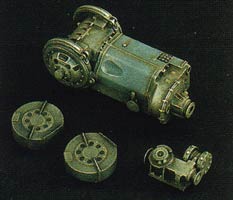 |
Transmission |
src: Verlinden
|
Le toit du compartiment avant comportait une large
trappe boulonnée servant en cas échéant à
l'entretien de la transmission. Sur cette trappe se trouvaient deux trappes
montées sur pivot pour le pilote et le radio-mitrailleur. Sur les
modèle G, les trappes sont montées sur charnières.
The roof of the steering compartment
comprised a broad plate which was bolted into place, to allow easy access
when it was necessary to work on the transmission. On this plate were
two hatches, mounted on pivots, for the driver and the radio-machine gunner.
On the model G, the hatches were mounted on hinges.
Le tireur était assis dans la tourelle à la gauche du canon. Pour sa visée, à l'origine le tireur disposait d'une lunette binoculaire TZF 12 articulée qui dès le modèle A fut remplacé par la lunette monoculaire TZF 12a. La mise à feu du canon était électrique, et se faisait via une détente située sur le volant de pointage verticale. Une mitrailleuse coaxiale était située à la droite du canon et était toujours actionnée par le tireur via une pédale. Le pointage de direction de la tourelle se faisait hydrauliquement ou manuellement via un autre volant quelque soit le mode. Le commandant était assis à l'arrière du tireur en surplomb. Il disposait d'une coupole de type "tambour" à six fentes de vision à épiscopes sur l'Ausf.D qui fut remplacée par une nouvelle coupole en forme de dôme à 7 épiscopes. La trappe sur le premier modèle étit montée sur charnière alors que celle du suivant l'était sur pivot. Sur le deuxième type de coupole était monté parfois une circulaire pour une MG 34 anti-aérienne.
The gunner sat in the turret to the left of the gun. In order to aim the gun, the gunner initially had TZF 12 articulated binocular sights, which in the model A were replaced TZF 1A monocular sights. The gun was fired electrically, via a trigger located on the elevation handwheel. A coaxial machine-gun was located to the right of the gun and was fired by the gunner via a foot pedal. Turret traverse was done hydraulically, although there was a manual backup, via a handwheel. The commander sat behind the gunner, in the turret rear overhang. On the Ausf D, he used a “drum-type” cupola, with six vision slits with episcopes, which was subsequently replaced by a newer “dome-shaped” cupola, with 7 periscopes. The hatch on the first model was mounted on a hinge, whereas that of the following was on a pivot. Sometimes on the second type of cupola there was fixed a circular rail on which an anti-aircraft MG 34 could be mounted.
.jpg) |
Panther Ausf.D1 |
.jpg)
|
Panther
Ausf.D2 |
.jpg) |
Panther
Ausf.A/G |
.jpg) |
Panther
Ausf.G (Spätes) |
Le chargeur quant à lui était installé à la droite du canon dans la tourelle. Les parois de la tourelle étaient inclinées. Le puits de tourelle disposait d'un plancher circulaire rattaché à la tourelle via des tubes en acier et pivotait donc avec elle. L'energie pour la rotation de la tourelle était prise sur une boîte de transmission à travers le centre du plancher. Cette boîte était elle même reliée à un moteur à pétrole. Le compartiment de combat comportait très peu d'ouvertures: il y avait une grande trappe montée sur charnière sur la parois arrière de la tourelle, qui servait d'accès à l'équipage et au chargement des munitions ou à l'évacuation des douilles - une petite trappe sur la parois gauche de la tourelle en dessous de la coupole servait également à l'évacuation des douilles, cette trappe fut cependant supprimée à partir de l'Ausf.A - trois petites tapes de tir au pistolet qui furent également supprimées à partir de l'ausf.A.
The loader sat to the right of the gun, in the turret. The walls of the turret were sloped. In the turret well was a circular floor attached to the turret via steel tubes, which swivelled along with the turret. Power for the turret traverse was taken off a gearbox, through the center of the floor. This box was connected to an oil-engine. As might be expected, the fighting compartment had relatively few openings: there was a large hatch, on hinges, mounted on the back wall of the turret. This was used as access for the crew, for loading ammunition or removing empty shell casings. There was another aperture for the removal of shell casings, a small hatch on the left wall of the turret, below the cupola. However, this hatch was eliminated on the Ausf.A model, as were three small pistol firing ports.
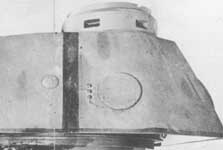 |
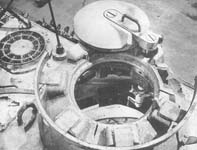 |
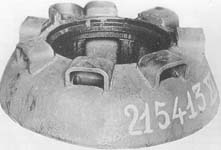 |
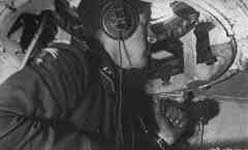 |
(Haut à gauche) Coupole de
commandant du Panther Ausf.D avec 6 fentes de vision et une trappe
montée sur charnière. (Le reste) Coupole de commandant du Panther Ausf.A et du Panther Ausf.G avec 7 épiscopes fixes et une trappe montée sur pivot. |
|
(Top, on the
left) Cupola of commander of the Ausf.D Panther with 6 slits of
vision and an access hatch assembled on hinge.
(The remainder) Cupola of commander of the Ausf.A Panther and the Panther Ausf.G with 7 fixed episcopes and access hatch assembled on pivot. |
|
src:Osprey Military, Site "The
Desert Fox", Osprey Military
|
|
 |
|
src: ?
|
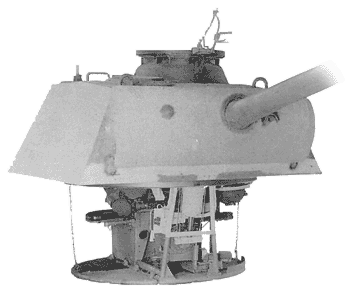 |
Wells of turret of the Panther |
src: Osprey Military |
L'arme principale du Panther était l'excellent 75 mm KwK 42 L/70 mis (à frein de bouche à double déflecteur) au point par Rheinmetall. Ce canon à grande vitesse initiale (935 m/s) était une arme formidable pouvant pénétrer 120 mm de blindage sous 30° à 900 m. Le masque du canon bombé sera remplacé sur les derniers Ausf.G par un masque doté d'un déflecteur pour protéger l'intérieur de la tourelle des éclats lorsque le canon était en position verticale maximum.
The main weapon of the Panther was the excellent 75 mm KwK 42 L/70 gun, with double deflector muzzle brake, developed by Rheinmetall. With a very high muzzle velocity (935 m/s) this gun was a formidable weapon: at 900 meters, the shell was able to penetrate 120mm of armor plate set at an angle of under 30° from the horizontal. The cylindrical gun mantlet was replaced on the Ausf.G, by a mantlet equipped with a deflector, to eliminate the “shot trap” caused by the earlier mantlet, which could deflect shells from its underside down into the hull.
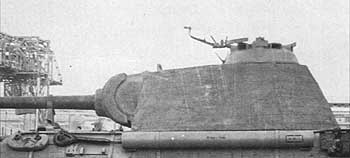 |
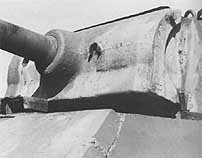 |
Old mantlet |
"anti-glares" late mantlet |
src: Site Panzer
Page von Reitsch
|
|
75
mm KwK 42 L/70 Penetration of a shielding plate (mm) under a plunging angle of 30° |
|||||||
Ammo |
Weight |
Velocity |
100
m |
500 m |
1000
m |
1500 m |
2000
m |
| PzGr 39/42 | 6.8 kg |
925 m/s |
138 |
124 |
111 |
99 |
89 |
| PzGr 40/42 | 4.75 kg |
1120 m/s |
194 |
174 |
149 |
127 |
106 |
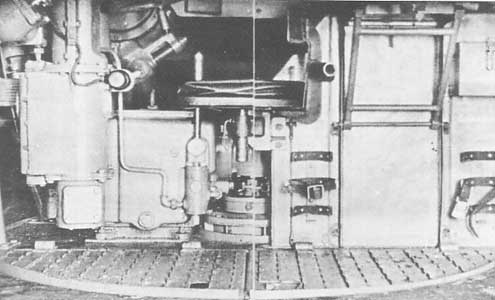 |
Combat compartment of the Panther |
src: Osprey Military
|
Sources:
- Pz.Kpfw V in action, Armor Number 11 (squadron/signal publications, inc.)
- Connaissance de l'Histoire (Hachette) - N°17 - " Les chars de combat allemands 39-45"
- Connaissance de l'Histoire (Hachette) - N°5 - " Véhicules blindés allemands 39-45"
- Les Blindés de la Seconde Guerre Mondiale (Atlas)
- Panther Medium Tank 1942-1945 (Osprey Military) - New Vanguard N°67
- Panther Variants 1942-1945 (Osprey Military) - New Vanguard N°22
- Site "Achtung Panzer" - http://www.achtungpanzer.com
- Site "Germany's vehicle history" - http://www.wwiivehicles.com/html/germany/index.htm
- Site "Second World War Armour" - http://www.onwar.com/tanks/index.htm